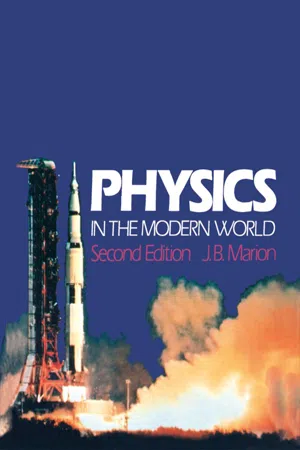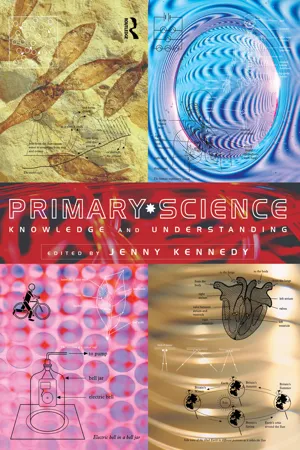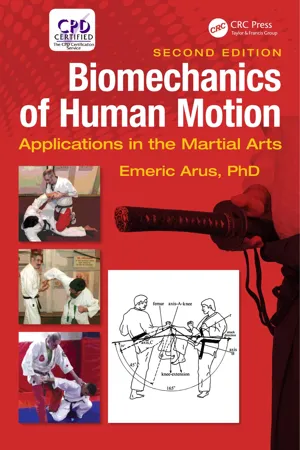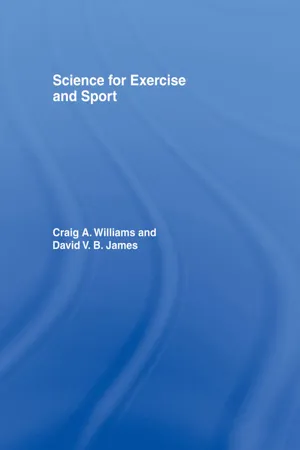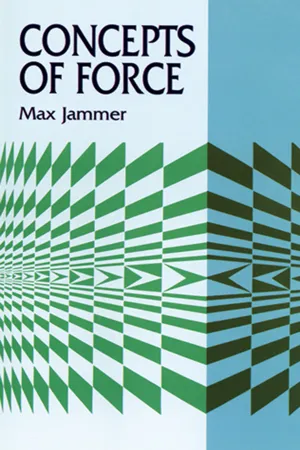Physics
Force
Force is a push or pull that can cause an object to change its speed, direction, or shape. It is a vector quantity, meaning it has both magnitude and direction. Forces can be described using Newton's laws of motion and are measured in units called newtons (N).
Written by Perlego with AI-assistance
Related key terms
12 Key excerpts on "Force"
- eBook - ePub
- Jerry Marion(Author)
- 2012(Publication Date)
- Academic Press(Publisher)
3Force
Publisher Summary
This chapter explains the concept of Force and its relation to the behavior of objects at rest and in motion. The mass of an object is important in any effort to change its state of motion. The property of an object that tends to resist any change in its state of motion is called inertia. The measure of an object’s inertia is its mass. The chapter discusses Newton’s first, second, and third law of motion. A Force is any influence that can cause a change in the state of motion of an object. Mass is an intrinsic property of matter; it is a measure of the inertia possessed by an object—that is, the tendency of the object to resist changes in its state of motion. Weight is the gravitational Force acting on an object, and this Force depends on the location of the object. Variation causes an object to have different weights even though its mass is constant.In the preceding chapter we developed methods for describing and analyzing motion. But what causes motion? You know that if you push or pull (sufficiently hard) on a lawnmower, it can be set into motion. Or, if you apply a restraining push or pull to a bowling ball, the ball can be slowed down and brought to rest. In every such case, some Force —represented by a push or pull—must be applied to an object in order to change its state of motion. In this chapter we examine the concept of Force and its relation to the behavior of objects at rest and in motion.3-1 Force AND INERTIA
Intuitive Ideas
The intuitive notion that a Force is a push or a pull is entirely consistent with the precise physical definition of this important quantity. We have other, equally correct intuitive ideas about Force. For example, if you push in a certain direction on an object at rest, the object tends to move in that direction. Or, if you wish to stop a moving object, you must exert a push in the direction opposite to that of the object’s motion. That is, Force has direction as well as magnitude —Force is a vector quantity. We also appreciate the fact that the mass of an object is important in any effort to change its state of motion. A kick applied to a soccer ball will send the ball flying; but a kick applied to a bowling ball will result in only a slight motion of the ball (and a bruised toe). The property of an object that tends to resist any change in its state of motion is called inertia; the measure of an object’s intertia is its mass - eBook - ePub
- Craig Williams, David James, Cassie Wilson(Authors)
- 2008(Publication Date)
- Routledge(Publisher)
laws of motion, and hence the laws that govern the effect of Forces. These laws are important in the study of exercise and sport, and relate to some of the information in this chapter. These laws can be summarised as:- Newton’s first law: Law of inertia – an object will continue in its state of rest or motion unless acted upon by an external Force.
- Newton’s second law: Law of acceleration – the rate of change of momentum of a body is directly proportional to the Force causing it, and the change takes place in the direction in which the Force acts.(5.1)
- Newton’s third law: Law of action–reaction – to every action created by a Force, there is an equal and opposite reaction.
When applying these laws, it should be remembered that the laws are only true for rigid bodies. Since the human body is not a rigid object, the laws should therefore be applied cautiously.UNITS OF Force AND PRESSURE
A quantity with a magnitude (i.e. size) only is known as a scalar quantity. Force is a vector quantity, which means it has a directional component in addition to a magnitude (see Chapter 9 ). A Force is visualised through the action it has on an object. Specifically, acceleration is the kinematic (i.e. movement) effect associated with the action of a Force. The magnitude of a Force is equal to the product of mass (kg) and acceleration (m.s–2 ) (see Equation 5.2). The unit of measurement of Force is the newton (N). One newton is the Force which when applied to a mass of 1 kg causes it to accelerate at 1 ms–2 .(5.2)Whilst Forces are important in exercise and sport, it is often a combination of the magnitude of the Force and the time over which it acts which is related to performance. The product of Force (N) and time (s) is impulse - eBook - ePub
- Serhii Stepanov(Author)
- 2018(Publication Date)
- De Gruyter(Publisher)
5Force and equations of motion Although much information about particle interactions can be derived from the conservation laws, equations of motion are required for a more detailed description.We will study the concept of Force and a generalization of Newton’s second law to describe particles moving in an external Force field. We will then find out which properties a Force should have so that the total energy and the total momentum of a particle are conserved. In general, such a Force can be a function of the particle’s velocity.We consider the motion of relativistic particles subject to a constant Force, a central field, and a spherically symmetric field. If in the spherically symmetric case the Force is a function of the test particle’s velocity, the particle’s orbit is subject to additional precession in accordance with Einstein’s theory of gravity.5.1Definition of Force
Predicting the future is the main task of physics. In classical mechanics, the dynamics of particles are described by second-order differential equations. Therefore, their coordinates can be found as functions of time from their initial positions and velocities. The situation is much more complex in relativistic mechanics, so a new dynamic quantity, the interaction field, must be defined in order to describe a system of interacting particles. Nevertheless, the classical approach involving second-order differential equations can be used for “small” particles moving in an external field. Particles which have no counter-impact on the sources of the Force field are called test particles.Newton’s second law is in some sense a definition of Force in classical mechanics:F = m a(i.e. Force is a function of the particle’s position and velocity and is proportional to its acceleration). The same definition can be written as F = d p /dt , where p = m u is the non-relativistic momentum of the particle. These two relations are not equivalent in relativistic theory where the following definition - eBook - ePub
Primary Science
Knowledge and Understanding
- Jenny Kennedy(Author)
- 2013(Publication Date)
- Routledge(Publisher)
9 Forces and Motion JIM JARDINE AND JENNY KENNEDY Introduction What is a Force? What can Forces do? Other Forces Forces on a motionless object Weight Floating and sinking Forces always come in pairs Falling objects – air resistance Friction between solids Keeping going Speed SummaryPassage contains an image
9
JIM JARDINE JENNY KENNEDYFORCES AND MOTIONINTRODUCTION
The meaning of the word ‘Force’
In general use, the word ‘Force’ often conveys the idea of intense effort and even violence. But in science a Force is simply a push or a pull, no matter how small. You exert a small Force to blow a crumb from the table (a push), or to lift a spoon (a pull). If a broken-down car is to be shifted, you could exert a large push from behind, or get a breakdown truck to exert a large pull forward, or a crane to exert a large Force upward to lift it on to the truck.In Figure 9.1 arrow-heads are used to show the directions of the Forces mentioned and the places where they are applied, although there is nothing to indicate the relative sizes of those Forces.WHAT IS A Force?All around us there are examples of Forces being exerted. You provide Forces when you push a bicycle along, pull a push-chair up a step, open a drawer, throw a ball, and so on. A Force is a push or a pull. Notice that a Force is needed to start something moving, although, as we shall see, a Force may not be necessary to keep it moving.It is important to realise that in each of those examples there are also many other Forces acting on the objects shown. In the case of the bike, in addition to the girl’s push, there is the pull of gravity downward, which we call the bike’s weight; the support of the ground pushing up on the bike; and the frictional Forces of the road on the tyres and of the air pushing back on the whole bike (see Figure 9.2 - eBook - ePub
Biomechanics of Human Motion
Applications in the Martial Arts, Second Edition
- Emeric Arus, Ph.D.(Authors)
- 2017(Publication Date)
- CRC Press(Publisher)
The kilogram (kg) is an SI base unit of mass. From here results that a mass of 1 kg = 9.8 m/s 2. A man of 70 kg mass × 9.8 m/s 2 will have 686 Newton Force. 8.2 ForceS Recall that kinetics deal with motion that includes the Forces that cause the motion. The physical property of the Force, perhaps, is the most important between other physical properties, such as momentum, impulse, energy, velocity, and so on, which are related to objects in static positions or dynamic motions, including humans and animals alike. Force is described as the effect one object has on another, which can alter the state of a matter by pushing, pulling, twisting, sliding, and so on, and this effect of the Force (F) is the product of a mass and its acceleration F = m ⋅ a. There are many different kinds of Forces such as internal Forces; for example, in biomechanics, a muscle contraction produces internal Forces that move a segment of the body. External Forces represent actions on the system of the human body such as a pushing, pulling, or twisting Force or even push of the wind. The gravity and inertial Forces have been described in Chapter 6. Force is a vector quantity that includes magnitude and direction. The Force of action usually includes a point and a line of application. The Force vector is represented by an arrow, usually a straight line from the origin of the Force that shows the direction of the Force and the length of the arrow represents the magnitude of the Force. Other vector quantities are velocity, acceleration, momentum, torque, and impulse. In the human body, the Force is represented by the skeletal muscle. A specification that is important to be mentioned here is that muscles can execute only pulling actions. To better understand the pulling actions of the muscles, here is the explanation: When you pull a cart, you say there is a pulling action of the biceps muscle. But when you push a table, you probably will say there is a pushing action - eBook - ePub
- A. L. Stanford, J. M. Tanner(Authors)
- 2014(Publication Date)
- Academic Press(Publisher)
particle dynamics , the subject of this chapter.The principles that relate Force and motion were formulated by Isaac Newton (1642–1727), These principles, now referred to as Newton’s laws of motion, are profound insights into the natural processes involving Force and motion. Here we shall state and discuss each of Newton’s laws and illustrate their usefulness in a number of physical situations.3.1 Newton’s First Law
A body has a constant velocity unless it is acted on by a net Force .To say that a body has a constant velocity is to say that the body experiences no acceleration. The words net Force in the first law remind us that many individual Forces may act on a body, but the resultant or net Force must be equal to zero if the body is not to accelerate. We should also recognize that because Force is inherently a vector quantity (one may not push or pull on a body without doing so in a particular direction), the net Force on a body is the vector sum of all the Forces acting on that body.Consider one implication of the first law. The assertion that a body on which there is no net Force experiences no acceleration implies that a moving body will maintain a constant velocity forever unless acted on by a net Force. We intuitively expect a body at rest to remain at rest when no Forces act on it, but the first law asserts that constant velocity is an equally natural state of motion. Of course, none of us has ever experienced the situation in which no Forces are present on a body. We must, therefore, imagine, just as Newton did, the idealized situation in which there is no gravity, no friction, no Forces of any kind. In such a situation, a body at rest would remain at rest forever, and a body moving with a given velocity would move with that velocity forever. - eBook - ePub
- David James, Craig Williams(Authors)
- 2014(Publication Date)
- Routledge(Publisher)
The effect of Force is observed through changes in motion, and hence Newton’s laws of motion are important in understanding such an effect. However, Newton’s laws are valid only for rigid bodies, so application of them to the human body should be done with caution. Force is the product of mass and acceleration of an object. When Forces are generated by muscle contraction in the human body, the magnitude of these Forces is normally measured as torque about a joint. Functionally, torque is important, since it is the product of Force applied and distance between the joint and the point of application of the Force. Force can be applied to solid objects, but compression Force can be applied only to rigid solids, whereas tension Force can be applied to all solids. Pressure (i.e. Force per unit area) can be applied to solids and fluids (i.e. liquids or gases). With regard to sport and exercise, the time over which Force is applied is important for the resulting motion; the product of Force and time is known as impulse. In a sport and exercise laboratory, Force between an object and the ground may be measured using a Force plate. Additionally, muscle Force production can be assessed through torque about a joint. With modern equipment, torque can be assessed when the muscle is working isometrically, isokinetically or isotonically.KEY POINTS
• The effect of Force is observed through the change in motion of an object.• Force is equal to the product of the mass and the acceleration of an object.• Newton’s first law of motion is the law of inertia: a Force is required to stop, start or alter the motion of an object.• Newton’s second law of motion is the law of acceleration: the acceleration of an object is proportional to the Force acting on it, and takes place in the direction of the Force.• Newton’s third law of motion is the law of action—reaction: to every action created by a Force there is an equal and opposite reaction.• The duration over which a Force acts is functionally important, and the product of Force and time is known as impulse.• Force can act on a rigid solid as compression or tension, and act on a non-rigid solid as tension only.• Pressure is Force per unit cross-sectional area.• Pressure can act on all states of matter, but on liquids and gases only if they are contained.• Force is measured through strain gauges.• Torque is the Force operating about a point of rotation, and is calculated as the product of the Force and the distance between the point of rotation and the point of Force application.• Torque is functionally important in sport and exercise since Force is applied in the human body through a series of levers.• Joint torque—velocity relationships give a functional insight into muscle Force—shortening velocity relationships.Bibliography
Astrand, P-O. and Rodahl, K. (1986) Textbook of Work Physiology: Physiological Bases of Exercise - eBook - ePub
- Hiqmet Kamberaj(Author)
- 2021(Publication Date)
- De Gruyter(Publisher)
Fig. 5.2 , which keeps the objects bound on the surface of the Earth. The planets of our Solar System are bound to the Sun by the action of gravitational Forces. Other examples of the field Forces include the electrostatic Forces between the charged particles.Figure 5.2 Example of applied non-contact Force.5.2 Measuring the strength of a Force
The strength of the Force can conveniently be measured using the deformation of a spring. For that, suppose we apply a horizontal Force to a spring scale that has a fixed left end, as shown in Fig. 5.3 (a).Figure 5.3 Testing the vector nature of the Force using the spring, which is fixed on the left-hand side and on the right-hand side, it experiences an external Force. Under the influence of the external Force on some arbitrary direction, as indicated, the spring extends by x until an equilibrium is established between the external Force and the spring Force, where k represents the stiffness of the spring. The mass of the spring is ignored, and hence gravitational Force on the spring is omitted. External Forces and their directions with respect to the horizontal direction are: (a)F s= − k xF 1parallel to horizontal line; (b)F 2() parallel to horizontal line; (c)F 2= 2F 1F =forming an angle θ with horizontal line.F 1+F 2If we apply a Force on the spring, then it elongates. A pointer can then read on the scale the value of the Force acting on the spring. Calibration of the spring can be performed by defining the unit ForceF 1, which represents the Force that produces a pointer reading of1.00 cm. If we now apply a different horizontal Force to the rightF 2whose magnitude is 2 units, as seen in Fig. 5.3 (b), the pointer will move to2.00 cm. Fig. 5.3 (c) shows that, if the Forces are not linear (for example, they are perpendicular to each other), then their net effect is the sum of the two Forces. Suppose that two Forces act on the spring simultaneously withF 1upward andF 2horizontal, as illustrated in Fig. 5.3 (c). In this case, the pointer reads. The single Force F that would produce this same reading is the sum of the two vectors5.00= 2.24 cmcm 2F 1andF 2, as described in Fig. 5.3 - eBook - ePub
Making Physics Fun
Key Concepts, Classroom Activities, and Everyday Examples, Grades K?8
- Robert Prigo(Author)
- 2015(Publication Date)
- Skyhorse(Publisher)
electromagnetic Force is also everywhere. Through the electromagnetic Force, electrons bind to nuclei to form atoms, atoms bind to other atoms to form molecules, and molecules bind together to form solids and liquids. Indeed, this Force holds most objects together. But this Force can also repel objects. The reason that a chair can hold me up is a result of an overall electrical repulsion between my bottom and the chair seat (the repulsion is mutual, the chair exerts an electrical Force on me and I exert an equal electrical Force back on the chair). Indeed, essentially all contact Forces (objects touching or hitting each other) that we see around us are fundamentally electromagnetic in nature. Friction is an electromagnetic Force resulting from the creation and breaking of electrical bonds between two surfaces that have been pushed together (often pushed together by the gravitational Force). Electromagnetic Forces can be both attractive (pulling) and repulsive (pushing).The two remaining fundamental Forces, the strong Force and weak Force, while central to our understanding of processes at the subatomic level, do not manifest themselves directly in the macroscopic world in which we live.All Forces in nature, whether at the fundamental level or when manifested at the macroscopic level, share a beautiful symmetry property: all Forces come in pairs. There is no such thing as a single Force. What’s more, the pairs are of equal strength and always oppositely directed. It is important to note that these Force pairs are always exerted on different objects. For example, when I push on a wall with my hand (Force exerted on the wall ), the wall exerts an equal and opposite Force back on my hand (Force exerted on my hand ). These Force pairs are essential in all types of locomotion—walking, jumping, flying, driving, rockets. See the “Everyday Examples” section below for more details.Here are three equivalent statements of this symmetry principle, known as Newton’s Third Law of Motion:When two objects “interact” with each other, that is, when two objects exert Forces on each other, they always do so with equal strength and in the opposite directions. Forces between objects always occur in equal and opposite pairs. When object 1 exerts a Force on object 2, object 2 exerts a Force back on object 1 of the exact same strength but in the opposite direction.It has become quite common to cite Newton’s Third Law in terms of “action and reaction,” but this can lead to an unfortunate misconception. One often hears, “For every action there is an equal and opposite reaction.” This is misleading because while the Forces are in fact the same, the action and reaction may not be the same. For example, if the two objects that are interacting have different masses, then the action and reaction responses will not be the same. The more massive object will respond to the same Force with much less change in its motion (less acceleration) while the less massive object will react to the same Force with a larger change in its motion (larger acceleration). This important idea will be discussed later under Newton’s Second Law of Motion. - eBook - ePub
Doing Physics with Scientific Notebook
A Problem Solving Approach
- Joseph Gallant(Author)
- 2012(Publication Date)
- Wiley(Publisher)
Chapter 5Newton’s Laws of Motion
In the previous chapters on kinematics, we described motion in a quantitative sense. Once we know an object’s acceleration, we can describe its motion in terms of position, velocity, and time. Knowing how its motion changes lets us calculate how far, how fast, and how long the object moves.Now we move to a branch of physics known as dynamics. Dynamics is the study of the effects of Forces on an object’s motion. Dynamics explains changes in motion by relating the cause of the changes (Forces) to the effect (acceleration). Newton’s Second Law provides the rule relating the acceleration to the net Force.There are three ingredients to Newton’s Second Law: the object’s acceleration, mass, and the net Force acting on it. As we discussed in Chapter 2, the object’s acceleration is the rate of change in its velocity. Mass is a property of the object that determines how much change the net Force produces. An object’s mass tells you how difficult it is to change its velocity and how much matter it has.A Force is a push or a pull that can cause changes in motion. Forces are vectors, so they have magnitude and direction. This is consistent with your experience. When you exert a Force on something, two things matter: how hard you push or pull and which way. Often objects have more than one Force acting on them. The net Force acting on an object is the vector sum of all the Forces acting on it.Newton’s First Law
Newton’s First Law tells us what happens when there is no net Force acting on an object.Newton’s 1st Law: An object will remain in a state of rest or continue in motion at a constant velocity unless compelled to change by a non-zero net Force.When there is no net Force acting on the object, there is no change in the object’s velocity. If it is at rest, it remains at rest. If it is moving, it keeps moving at constant velocity. Since velocity is a vector, constant velocity means no change in both speed and direction. Motion at constant velocity is motion in a straight line at a constant speed. - eBook - ePub
- Max Jammer(Author)
- 2012(Publication Date)
- Dover Publications(Publisher)
Lex III: Actioni contrariam semper et aequalem esse reactionem: sive corporum duorum actiones in se mutuo semper esse aequales et in partes contrarias dirigi.The first axiom, the principle of inertia, may either be interpreted as a qualitative definition of Force or, if Force is taken as recognisable in a manner independent of the laws of motion, as an empirical statement describing the motion of free bodies. The second law, likewise, has two possible interpretations: it may serve as a quantative definition of Force or as a generalization of empirical facts.303 In modern notation the law, according to Newton, asserts F ∝ (mv).Since Newton clearly distinguishes between definitions and axioms (or laws of motion), it is obvious that the second law of motion was not intended by Newton as a definition of Force, although it is sometimes interpreted as such by modern writers on the foundations of mechanics. Nor was it meant to be merely the statement of a method of measuring Forces. Force, for Newton, was a concept given a priori, intuitively, and ultimately in analogy to human muscular Force. Definition IV, therefore, is not to be interpreted as a nominal definition, but as summarizing the characteristic property of Forces to determine accelerations.Yet, at the end of the discussion following Definition VIII, Newton declares:I refer the motive Force to the body as an endeavor and propensity of the whole towards a centre, arising from the propensities of the several parts taken together. . . and the absolute Force to the centre, as endued with some cause, without which those motive Forces would not be propagated through the spaces round about; whether that cause be some central body (such as is the magnet in the centre of the magnetic Force, or the earth in the centre of the gravitating Force), or anything else that does not yet appear. For I here design only to give a mathematical notion of those Forces without considering their physical causes and seats.304 - eBook - ePub
- Michael M. Mansfield, Colm O'Sullivan(Authors)
- 2020(Publication Date)
- Wiley(Publisher)
3 .Further experimental investigations confirm that it is valid to treat Force as a vector and that if a number of Forces act on a body, the body will behave in exactly the same manner as it would if a single Force equal to the vector sum of the individual Forces acted on it. Thus Newton's Second law, Equation (3.3) , can be generalised to deal with situations involving many Forces producing motion in three dimensions by writing it in the following vector form(4.3)where F is understood to be the vector sum of all the Forces acting on the mass m.We can also generalise the definition of momentum, given in Section 3.3 , to take its vector nature into account as followsand thus, in terms of momentum, Newton's second law can also be written in vector form asIf the Force acting on a body is a function of time, that is if its magnitude or direction or both vary with time (F = F(t)), the acceleration will change correspondingly with time (a = a(t)), in which case Equation (4.3) can be considered to hold instantaneously, that isIn many everyday situations the Forces which act on bodies may be constant. One such example, as we have already observed, is the Force due to gravity on a body near the surface of the Earth. As long as the mass does not move over too great a vertical distance, the pull of gravity vertically downwards on the body, which we called its weight (W) in Section 3.4 , does not change. A body of mass m
Index pages curate the most relevant extracts from our library of academic textbooks. They’ve been created using an in-house natural language model (NLM), each adding context and meaning to key research topics.
